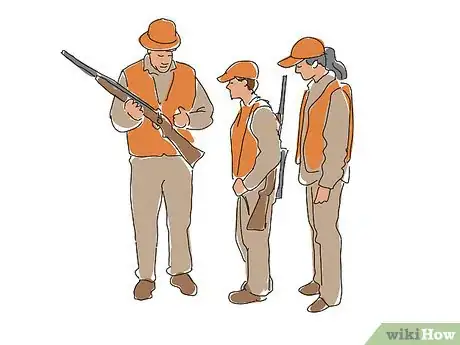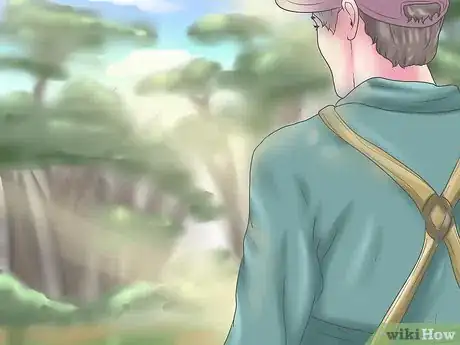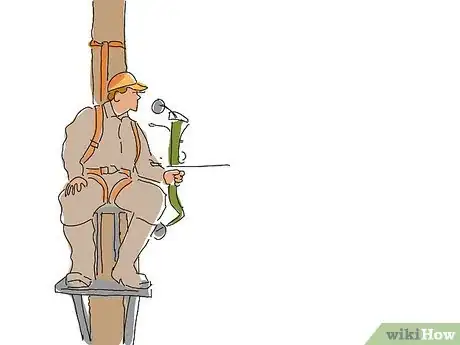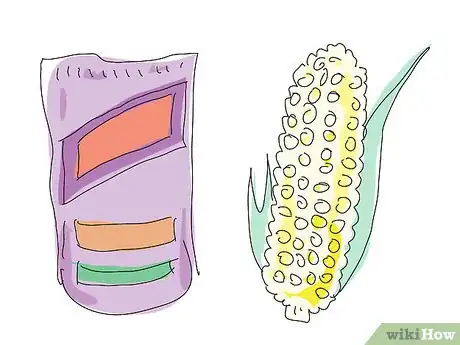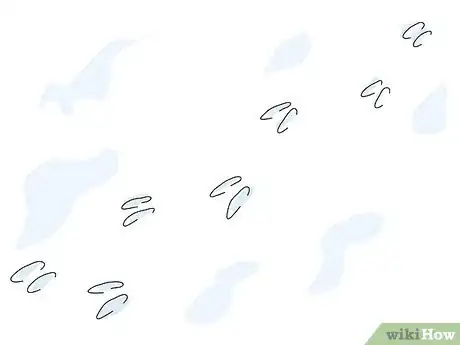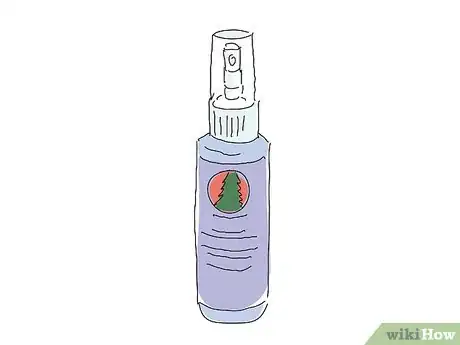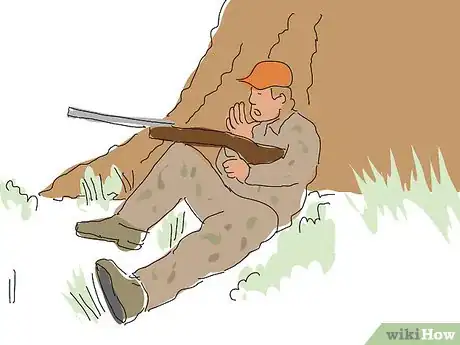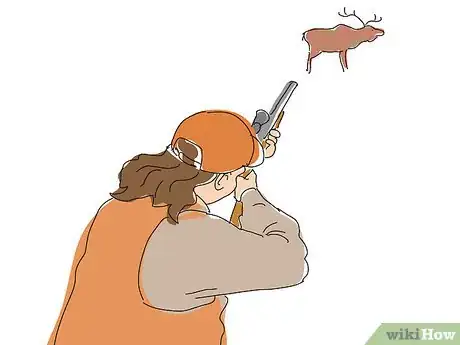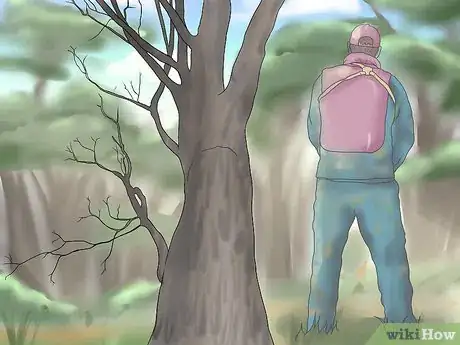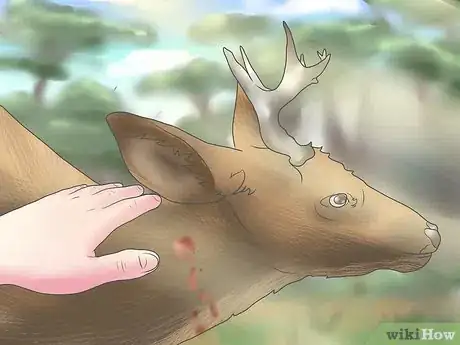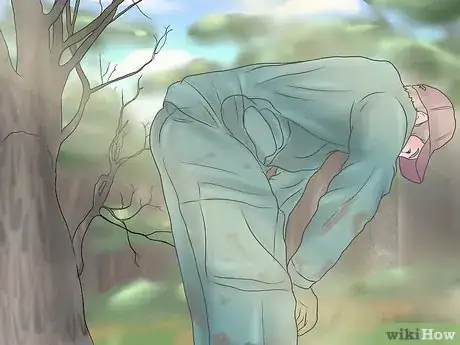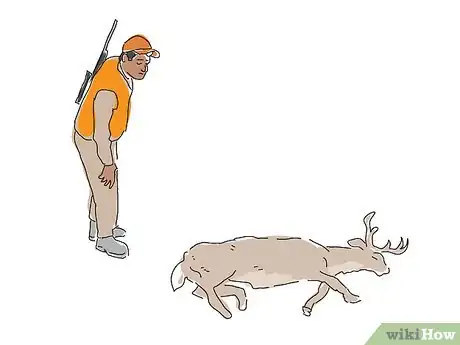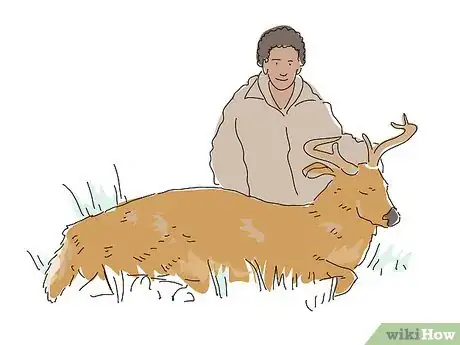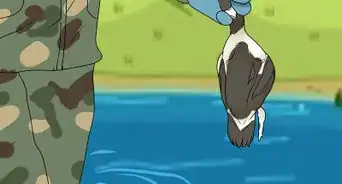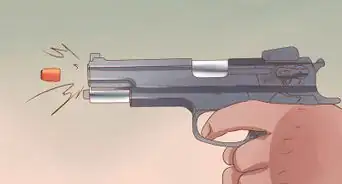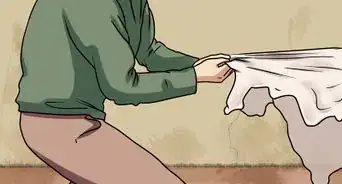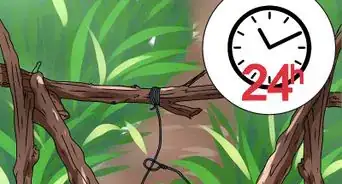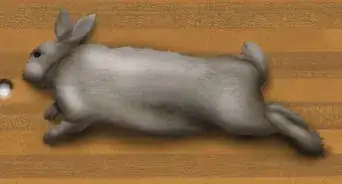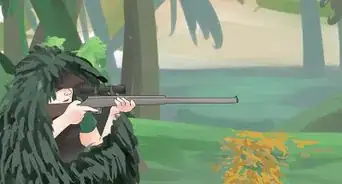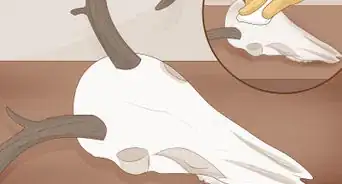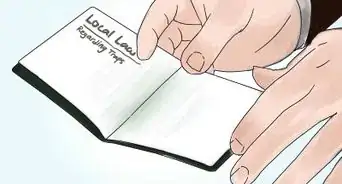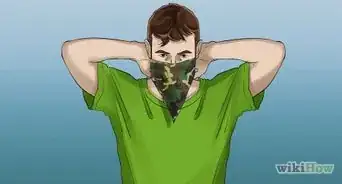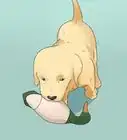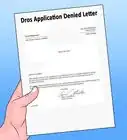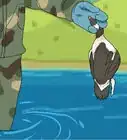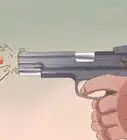wikiHow is a “wiki,” similar to Wikipedia, which means that many of our articles are co-written by multiple authors. To create this article, 82 people, some anonymous, worked to edit and improve it over time.
There are 8 references cited in this article, which can be found at the bottom of the page.
This article has been viewed 289,388 times.
Learn more...
Deer meat is one of the healthiest sources of animal protein for human consumption. Hunting deer is almost always a unique experience, whether or not you bag a big one. Of course, your goal should always be to an on target, quick and humane kill, but sometimes just communing with nature in the vast outdoors is all it takes to boost your spirits. If you want to increase your chances of success, and have fun doing it, here are some essential pointers for your deer hunting excursion.
Steps
Preparing for the Hunt
-
1Get the necessary permits from your local Department of Environmental Conservation (DEC) Office or Department of Natural Resources (DNR) or other regulatory body. Visit their website. They will give you all the information on permit(s) you will need to start hunting. Your permit should cost anywhere from $40 to $200, depending on your location, and will contain the following essential information:
- How long the deer season lasts. Usually, the "season" is broken up into weapon class — i.e. one season for guns, one season for bow and arrow, etc.
- How many deer you can tag
- What kind of deer you can tag
- Other safety regulations, such as clothing essentials and hunting hours[1]
-
2Keep in mind your state's laws concerning firearms. While you don't need a firearm to go deer hunting, it is the most popular form of deer hunting. Go to your local law enforcement office and ask. Do exactly what is required of you to obtain a firearm. Do not fool around — follow the law! If you cannot handle a firearm for legal or medical reasons, consider bow hunting which is just as exhilarating as hunting with a firearm. Once you understand which permit(s) you need, apply accordingly.Advertisement
-
3Get your clothing in order. What you wear may seem trivial, but it can be more important than you think. When you're dealing with other hunters, trying to blend in, and sitting for long periods of time, what you decide to wear is a crucial decision.
- Orange. Deer cannot see very well.[2] If you'll be handing a firearm, be sure to check state regulations for how much orange you need to wear, which is required in most, if not all, states.
- Camouflage. Complete the outfit with a nice combo of camo — both to blend in and to look cool. Depending on what season you'll be hunting in, you may want to vary the type of camo you use.
- Hunting boots. Purchase a pair of Gore-Tex, 800-Gram of Thinsulate-Ultra Insulation, Cordura Nylon. The Gore-Tex makes your boots waterproof, the 800-Gram of Thinsulate will keep your feet warm, and the cordura Nylon is low maintenance compared to leather.
-
4Get some proper equipment. Aside from your weapon of choice, your clothing, and your indefatigable pluck, you're going to need some equipment essentials when you go on your hunt. Here are the basics of what you'll need. You may want more based on personal preferences, but if you exhaust the following list, you should be good to go.
- Hot seat. This will keep your rear warm as you sit in the woods. Get a thick foam hot seat. Sew a loop about eight inches long, fasten it to your hot seat and clamp it to the loop on the back of your pants. Use your hot seat only if the weather is very cold, or is raining or snowing… Some hunters just like to sit on something soft and warm…. By the way, you can stand on a hot seat if it is extremely cold.
- Binoculars. Let's be honest: most of the time you'll spend "hunting" will actually be spent waiting. If you have a trusty pair of binoculars, you'll be able to spot the deer well before they're in range, leaving you prepared for the kill.
- Rangefinder. A rangefinder can be extremely useful for making sure that when you finally do spot that deer, you don't miss your shot when it's time to take it.
- Fanny-pack or Bum-Bag kit. Consider bringing a fanny pack with the following essentials: bug repellant, flashlight, knife and sharpening stone, small first-aid kit, compass, and a butane lighter.[3]
- Get the correct weapon and ammunition. This is always important for when you hunt because if you shoot a deer with the wrong gun you get your licenses and permits taken away.
-
5Find out where the best deer roam. When you're hunting for a meat animal, you got to know where to look. The thing is that big bucks are smart bucks. They've grown old for a reason: they tend to avoid human interaction and take pains to isolate themselves from potentially dangerous situations. Shooting a younger mature deer will likely make for better table fare. Here are some pointers on where to look for deer:
- Choose the densest, most inhospitable places for man to travel through. Where man does not tread, the deer may roam. Dense cedar thickets, old swampland, you name it; look for a trail and set up a stand.
- Bigger bucks tend to bed and rest in shady, higher-altitude places. Here, they are most concealed and farther removed from threats like humans.
- Thick creek bottoms are also more likely hideaways for big bucks. These places allow them to rest and drink water in a relatively isolated area.
-
6Set up several climbing tree stands where you can hunt from, if necessary. Sometimes, tree stands will be already set up for you. Most of the time, you'll need to set them up yourself. Scout various locations before and during the hunting season, as deer change their habits. Alterations in weather and human activity greatly impact in their environment.
- There are several kinds of commercial tree stands that you can choose from. They include small, less expensive units, like hang-on tree stands and ladder tree stands, in addition to larger, more expensive units, like tripod tree stands as well as tower and box blinds.[4]
- Build your own tree stand by hoisting a simple wooden platform high enough up onto a tall tree. What the tree stand looks like doesn't matter as much as how secure and high up it is.
-
7Bait your area or plant a food plot if you have private land available to hunt on. Baiting can be a good way to remind deer that a certain location is good territory, so to speak. Many states won't let you hunt within 300 yards (274.3 m) of bait so stop baiting a week or 10 days before you hunt.As far as bait, deer particularly like:
- Corn
- Apples
- Carrots
- Mineral licks
- Sugar beets
During the Hunt
-
1Invite a friend or family member. Hunting is more enjoyable with a group of responsible and dependable friends and family members. If you hunt alone there are a few things you need to do differently for safety reasons:
- Always take a fully charged cellular phone.
- Tell someone that you are going hunting and the time you plan to return and stick to your return time. Have someone check on you just to make sure you returned safely.
- If you do not have firsthand knowledge of your hunting area you may want to carry a GPS device or do some research of the area such as purchasing a topographical map of the area and studying it; remembering that local landmark or stream could make that little difference if you should become lost.
-
2Look for signs in the woods as you begin hunting. Scrapes, rubs, and game trails are signs of deer frequenting a particular area. Be sure to hunt in shooting range from signs.
- Scrapes are spots in the ground that bucks have dug out during rutting season. The earlier you find scrapes in the hunting season, the more reliable indicator they are of good places to hunt.
- Rubs are abrasions made by rutting bucks who scrape their antlers against trees. The size of the rub is usually a good indication of the size of the buck.
-
3Use cover scent to conceal your odor when you hunt. Deer have amazingly keen senses, especially hearing and their sense of smell. Masking your own scent is a good means of giving yourself a better shot at that trophy buck.
- If you don't want to have to shell out beaucoup de bucks on cover scent, try using baking soda instead. Mix a tablespoon of baking soda with unscented soap and use it in the shower before the hunt. Put some in your boots; create a "lasagna" with your clothes by layering baking soda and clothes; you can even brush your teeth with baking soda if you're intrepid.[5] Baking soda is an easy and cheap scent cover for all manner of hunter.
-
4Lure or entice the deer over to where you are. Seasoned hunters will rely on myriad techniques to entice the deer over to where they're waiting. You have a number of different options:
- Try using deer calls. Deer calls can be made using your own voice or can be produced mechanically by using a "doe in estrus" can. ("Estrus" means a peak time for sexual receptivity.) Simply tip the can over with a quick folding wrist action to simulate the estrus bleat sequence.
- Doe estrus scent. Use doe estrus spray or bring along a rag soaked in doe estrus urine to the hunt. In some cases, the buck will follow the scent of the doe straight to you.
- Buck urine in the early season. Bucks get very territorial in the early season, especially when they're sparring. Covering your scent with or using buck urine in the early season can have its rewards.
- Rattling antlers in the early season. Rattling antlers sends a sign that other bucks are sparring, which attracts bucks in the early season especially. Use this to lure bucks from far away.
Making the Shot
-
1Be patient. If you've covered your scent, made the appropriate calls, and sent out the right pheromones, there's a good chance your buck will pass a very short distance in front of you. Be patient. Shooting to kill is a lot easier when your deer is within 20 or 30 yards (18.3 or 27.4 m). Don't take a far-off shot; chances are you'll miss the deer's vitals, spook off all the rest of the deer, and only manage to injure it (causing a slow, painful death).
-
2Stand up as soon as you get the chance. While the deer is approaching, but before he's gotten close enough, try to stand up. This is the biggest movement you will take and has the highest likelihood of spooking the deer if you do it too late.
- Standing is a very unstable position to shoot in. It is better to shoot in the prone, sitting, or kneeling position.
-
3Be as still as possible while you get ready to shoot. It's very important to stay as quiet as possible immediately before shooting, otherwise you risk spooking the deer. This will often depend on what kind of weapon you're using to hunt.
- If using a gun or crossbow, have your weapon fully loaded with the safety on. Then, all you need to do when you're ready to shoot is flip the safety off and pull the trigger. Don't be caught with your proverbial pants down and forget to load your weapon.
- If the deer is still walking and won't stop for you to get a good shot, make a short bleat sound. This will catch the deer's attention, giving you time to shoot. You must be quick though because if you take a long time to shoot after bleating the deer will spook and run away.
- If using a bow and arrow, be very methodical when you load your arrow in the draw. Try to stand up when bow hunting. It'll improve your form and won't limit the type of shots you can take.[6]
-
4Aim for the upper shoulder, neck, or brain. Place your shot right behind the front leg, 6 inches (15.2 cm) up from the chest. If hit properly, this shot will travel through the deer's vitals and kill it humanely. Other places to aim include the neck or the brain.[7]
-
5If you've hit the deer, inspect the blood. Your goal as a responsible hunter is a one-shot kill; that way, the deer is felled quickly, without much pain and suffering. To check what kind of shot you got off, look at the blood on the ground near where you shot the animal. If the blood is:
- Brown hair and pink blood, with air bubbles, you've probably hit heart or lung. That's great news. It means your deer is probably somewhere close and not going to suffer.
- Brown hair and dark red blood, you've probably hit the deer farther back, possibly in the liver. Your buck may survive a while longer than you'd like, although it should still die relatively quickly.
- White hair and thin or watery blood with bile or other stomach matter, you've possibly missed the one-shot kill. You may have to track the deer and deliver another kill shot to humanely eliminate it.
After the Hunt
-
1Try to pinpoint where exactly the deer was when you shot him. Start off with this location. From here try to pick up a blood trail recall what general direction the deer was heading in when it ran away. With your compass, GPS, and a buddy, head out in this direction, taking note where you're going.
- Try to wait 30 minutes before beginning to track the deer. This will give the deer a chance to lie down and possibly bleed out. If you follow the deer right away, adrenaline will kick in and the deer could travel much farther than he might otherwise.[8]
-
2Follow the blood trail until it takes you to the deer. Look at the brush and foliage off to the side of the trail for any signs of where your deer might have gone. Here are some tricks to help you keep the blood trail in sight:
- Use hydrogen peroxide in a spray bottle. Fill a spray bottle with hydrogen peroxide and mist an area lightly. Any blood will start to foam up, just like it does when you apply hydrogen peroxide to a cut.
- Use fluorescent light. A handy fluorescent light will retail for $20 and make the job of spotting blood, especially at dusk or dawn, a lot easier.
-
3When you do spot the deer, make sure it is dead. You may even want to call friend to help drag your deer out of the woods with you.
-
4Learn how to field dress a deer properly. Handling meat in the field is a craft, not something that can easily be learned from written directions. The majority of hunters learn from their mentor(s) and it is the preferred method for many reasons. Try to find an experienced hunting partner. Not only is is relatively unsafe to hunt alone, a hunting partner makes for a long, healthy friendship and they can help with tasks such as this.
-
5Enjoy your spoils. Respect the animal whose life has ended for your nutritional sustenance. Use all of its meat and only take as many tags as you need.
- You may also want to learn to butcher the deer yourself.
Community Q&A
-
QuestionIs it good to kill a deer?
 Community AnswerThere is an over population in some areas. If hunting them is legal locally, then yes.
Community AnswerThere is an over population in some areas. If hunting them is legal locally, then yes. -
QuestionDo I shoot a deer in the neck?
 Community AnswerNo, you should aim for the spot behind the front leg so you can shoot it in the heart.
Community AnswerNo, you should aim for the spot behind the front leg so you can shoot it in the heart. -
QuestionIf a group of deer is encountered while hunting, which deer of the group should be targeted?
 Community AnswerFrom what I know, target the biggest. If you shoot the gun it'll make a lot of noise and spook the rest of the deer. You also get more meat this way.
Community AnswerFrom what I know, target the biggest. If you shoot the gun it'll make a lot of noise and spook the rest of the deer. You also get more meat this way.
Warnings
- Always treat your firearms as though they are loaded. Always point the tip of the barrel away from people and be aware of your firearm's line of fire at all times… Always keep your safety on until you are ready to shoot at your target.⧼thumbs_response⧽
- Be sure to purchase a hunting license and take a hunters education course.⧼thumbs_response⧽
- Be one hundred percent certain that you're shooting a deer and not a human being.⧼thumbs_response⧽
- Read (from cover to cover) your State’s Hunting & Trapping Regulation Guide -- it's free and will be immensely useful.⧼thumbs_response⧽
- Never trespass on private property, obtain the landowner's written permission before hunting.⧼thumbs_response⧽
- Handle your firearm safely. Keep your finger off the trigger until you are ready to take a shot. Make this a habit.⧼thumbs_response⧽
- If you shoot but do not drop the deer, and the deer runs off, do not chase it or give away your position. Many a deer will trot a yards to cover then quietly bleed out. But, a deer that is chased can run for miles.⧼thumbs_response⧽
- Be careful climbing up and down trees.⧼thumbs_response⧽
- You can never hunt in a park. You can hunt in a National Forest. Be very sure you know the difference.⧼thumbs_response⧽
- Be sure to avoid areas where many bucks and does are known to roam. Most of the time, many bucks come here in order to mate with the does, so don't choose to go hunting just because you want to see a doe give birth to a fawn.⧼thumbs_response⧽
References
- ↑ http://dnr.wi.gov/topic/hunt/regulations.html
- ↑ http://www.fieldandstream.com/articles/hunting/2003/06/what-deer-see
- ↑ http://www.chuckhawks.com/deer_gear.htm
- ↑ http://www.cabelas.com/category/Hunting-Treestands/104783580.uts
- ↑ http://www.fieldandstream.com/articles/hunting/2012/08/get-rid-any-odor-baking-soda
- ↑ http://www.fieldandstream.com/blogs/whitetail-365/2012/10/when-stand-and-draw
- ↑ http://www.outdoorlife.com/blogs/big-buck-zone/2012/09/where-aim-kill-deer-one-shot
- ↑ http://www.ebay.com/gds/Tracking-a-Wounded-Deer-/10000000000084664/g.html
About This Article
Before you go deer hunting, get the necessary permits from your local Department of Environmental Conservation office. If you plan on using a firearm, visit the local police station to apply for a firearms permit. Then, choose your hunting outfit, making sure to include as many square inches of orange fabric as required by your state. Complete the outfit with a camouflage top and pants, and waterproof boots. Additionally, assemble a hunting kit with essentials such as a flashlight, binoculars, bug repellent, a butane lighter, and a small first-aid kit. To learn more, including how to make your shot once you spot a deer, keep reading.

